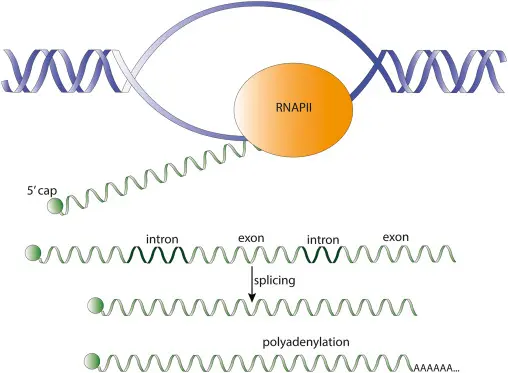Polyadenylation Signals and Their Structure
Mammalian pre-mRNA polyadenylation signals typically consist of two key components:
Upstream Element: This includes the highly conserved AAUAAA hexamer, which is essential for the polyadenylation process.
Downstream Element: This element is located immediately following the upstream signal and is involved in the cleavage and polyadenylation process.
The downstream element is often referred to as a U-rich or GU-rich region. While there is no universal consensus sequence for this downstream region, it is composed of several short motifs scattered at various distances from each other.
Key Features of Downstream Elements
U-rich Sequences: U-rich stretches (composed primarily of uracil residues) are commonly found in the downstream region. These sequences are crucial for polyadenylation efficiency and are often located 10 to 30 nucleotides downstream of the cleavage site.
GU-rich Sequences: Some pre-mRNAs also contain GU-rich sequences in the downstream region, which are recognized by specific polyadenylation factors.
G-Quadruplex Forming Sequences: A portion of the downstream elements can form G-quadruplex structures, which are four-stranded DNA or RNA structures stabilized by guanine bases. These sequences play a role in the regulation of polyadenylation.
Functional Role of Downstream Elements
The downstream element's main function is to guide the cleavage of the pre-mRNA and to ensure the proper addition of the poly(A) tail. The cleavage is performed by a complex of proteins, including the Cleavage and Polyadenylation Specificity Factor (CPSF) and the Cleavage Stimulation Factor (CstF). CPSF binds to the upstream AAUAAA signal, while CstF recognizes the downstream U/GU-rich element.
Interaction with CPSF and CstF: The interaction between CPSF and CstF helps in positioning the pre-mRNA for efficient cleavage and polyadenylation.
Cleavage and Polyadenylation: Once cleaved, the poly(A) polymerase (PAP) adds the poly(A) tail, a process that is also regulated by the downstream sequences.
Variability of Downstream Elements
No Universal Consensus: Unlike the upstream AAUAAA element, which is highly conserved, the downstream element does not follow a single consensus sequence. Instead, it consists of various short elements that are spaced differently across pre-mRNAs.
Functional Redundancy: Some pre-mRNAs have multiple functional downstream elements that can compensate for each other. This redundancy ensures the efficient functioning of polyadenylation across different genes.
In summary, the downstream elements of mammalian pre-mRNA polyadenylation signals are essential for proper mRNA processing. While the AAUAAA upstream signal is well defined, the downstream region is composed of a variety of short U-rich and GU-rich sequences, which interact with specific proteins to regulate polyadenylation. Although there is no universal sequence for the downstream element, understanding its components and their functions helps in advancing our knowledge of gene expression regulation.
To download or view the detailed PDF version of this document, click the link below:
